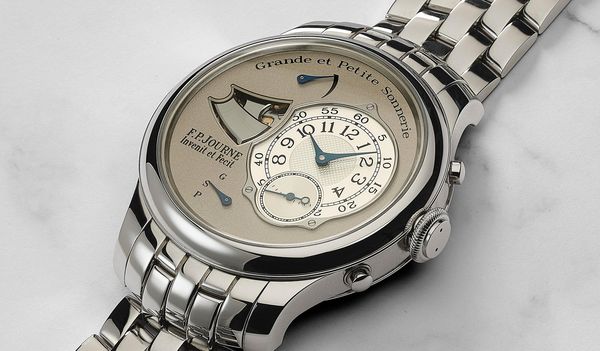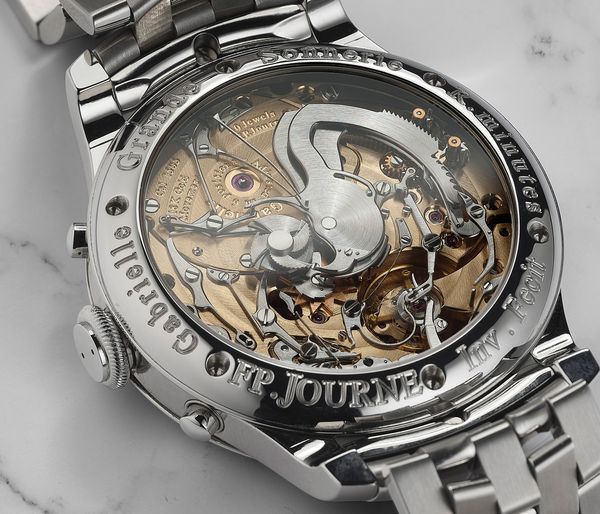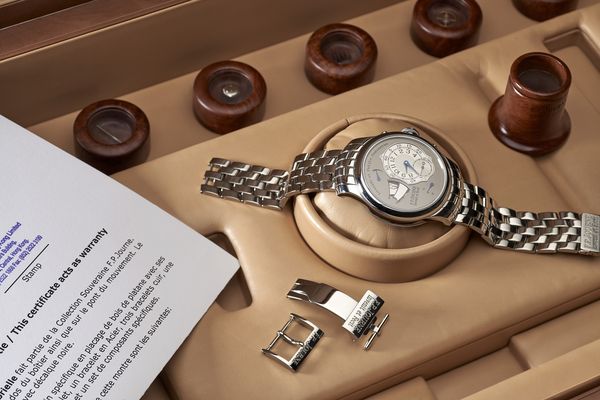There is an ever on-going conversation among collectors on what really is the highest of complications. The challenges to build a split second chronograph are well-known and often discussed, as well as the most involved calendar mechanisms such as those containing a leap year indicator or equation of time. Usually, the debate will move onto chiming watches, minute repeaters at the top of the list, but often the most intricate execution is overlooked: the sonnerie, be it grande or petite variants.
The reason they are so easy to escape one's mind is the fact that they are exceptionally rare as wristwatches, given the engineering challenges in creating a compact calibre that automatically chimes the passing hours and quarters. While pocket watch sonneries have existed since the 19th century, the complication did not make its leap onto the wrist until 1992, when the eminent Philippe Dufour achieved the great feat following on from the series of sonnerie pocket watches produced for Audemars Piguet in the 1980s.
A few years after Dufour’s debut, Piaget contracted a young watchmaker by the name of François-Paul Journe to emulate the complication for the crown jewel of their high-end Gouverneur range. While a series of 10 pieces was commissioned, the relationship would end before the final tally was reached, making it a pearl of incredible rarity, although monies from the project would help Journe to launch his namesake brand in 1999.
As soon as the Resonance and Tourbillon models were received by patrons, the question of when a Sonnerie would join the Souveraine collection was in the air, and Journe would start development of his own execution in 2000. It was clear that ease of use and durability would be paramount in such an intricate calibre, so in the six years of development, these factors were a key focus, ensuring even the least savant user could operate the watch without causing inadvertent damage with an incorrect operation or setting. Journe’s own benchmark was to “make it safe to use by an eight-year-old child”.
One of the big steps to facilitate this was the use of buttons to change functions via a column wheel and to actuate the minute repeater, as well as an ingenious system of locks to prevent time setting during striking by locking the crown, as well as stopping chiming when the crown is pulled. Usefully, a device prevents the sonnerie from striking in the last 24 hours of power reserve, as the going train and chiming train operate from a single barrel, preventing potential damage should there not be enough power available to complete the chiming sequence.
Of course with repeating watches, the sonic performance is of paramount importance, and there are a number of key features of the Journe Sonnerie Souveraine that make the most of the beautiful tones when the gongs chime. The racks that facilitate the strike are particularly large, with pronounced teeth to accurate delivery of the hours, quarters and minutes, while the gongs are of a particularly inventive design that allow them to generate exceptional sound without adding volume to the calibre. The most obvious focus on tonal quality is a case fabricated out of stainless steel for the material’s superior properties to transmit sound; precious metals that are traditionally employed in casing striking watches actually dampen the sound waves.
The Sonnerie Souveraine would result in 10 patents being awarded to F.P. Journe for its various innovations all primarily focused on usability, and François-Paul is proudly on record saying how few of the watches have come back to the workshop.
When the watch made its debut in 2006 it would almost immediately be awarded the Grand Prix d’Horlogerie de Genève’s Aiguille d’Or, and was met with widespread praise from the collectors’ community. With its lofty six-figure price tag it was always going to be a rarity, but rather than being simply restricted by the spending power of the enthusiast, the challenges of producing such a marvel, with only two watchmakers certified to assemble it, meant that approximately four pieces a year only would leave the manufacture in Geneva.
Discontinued in 2018, it means that perhaps just north of 50 pieces were produced during the lifetime of the Sonnerie Souveraine, with all of them bearing the name of the owner rather than a case number, proving how personal these watches are to those lucky enough to own them. As proof of Journe’s commitment to longevity, each watch was supplied with a kit of parts to aid with servicing, including, among others, a main spring, crown, stem, balance assembly, lever, and crystal, together with a steel bracelet and a selection of straps.
A crowning achievement for one of the greatest watchmakers to have lived, the Sonnerie Souveraine not only represents the total dedication to excellence that has come to embody the work François-Paul Journe, but also proves an important artefact in the founding of his company, representing the pinnacle of any collection that is fortunate enough to contain this rarity.



